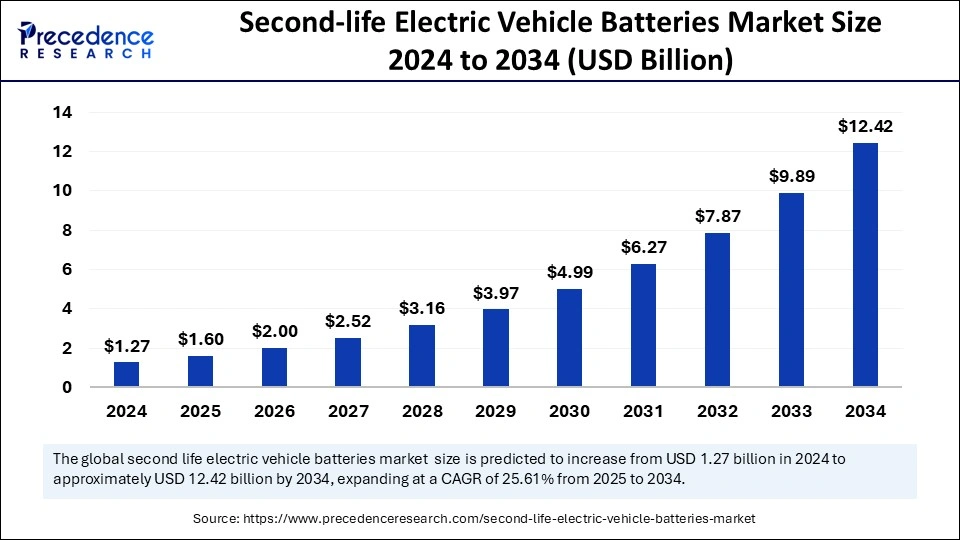Second-life electric vehicle batteries market is projected to grow from USD 1.27 billion in 2024 to USD 12.42 billion by 2034, with a CAGR of 25.61%

Second-life Electric Vehicle Batteries Market Key Takeaways
- Asia Pacific dominated the second-life electric vehicle batteries market with the largest share in 2024.
- Europe is projected to witness the fastest growth between 2025 to 2034.
- By battery type, the lithium-ion segment dominated the market in 2024.
- By battery type, the lead-acid segment is expected to grow at a significant rate during the forecast period.
- By application, the power backup segment held the largest share of the market in 2024.
- By application, the EV charging segment is projected to grow at a rapid pace during the forecast period.
- By end-use, the commercial segment dominated the market in 2024.
- By end-use, the residential segment is expected to experience the fastest growth between 2025 to 2034.
Second-life Electric Vehicle Batteries Market Overview
The global second-life electric vehicle (EV) batteries market is gaining significant momentum due to the increasing adoption of electric vehicles and the subsequent rise in retired batteries from these vehicles. Second-life EV batteries refer to batteries that have completed their initial use in electric vehicles but still retain approximately 70-80% of their original capacity. These batteries can be repurposed for less demanding applications such as energy storage systems, grid balancing, renewable energy storage, and backup power for commercial and industrial applications.
The growing emphasis on sustainable energy solutions, along with rising concerns about battery waste and environmental pollution, is driving the development of innovative solutions to extend the life cycle of EV batteries. As the global electric vehicle market continues to grow, with millions of EVs expected to enter the market in the coming years, the availability of second-life batteries is projected to increase significantly. Furthermore, second-life batteries provide a cost-effective and sustainable alternative to new battery systems, making them an attractive solution for various industries. Governments and regulatory bodies worldwide are also implementing stringent environmental policies and promoting circular economy initiatives, further accelerating the growth of the second-life EV battery market.
Second-life Electric Vehicle Batteries Market Drivers
-
Rising Adoption of Electric Vehicles (EVs): The growing popularity of electric vehicles is resulting in a surge of retired EV batteries, creating opportunities for second-life applications.
-
Increasing Demand for Energy Storage Solutions: The rapid integration of renewable energy sources into the power grid is driving demand for cost-effective energy storage systems, where second-life EV batteries play a crucial role.
-
Stringent Environmental Regulations and Circular Economy Initiatives: Regulatory bodies worldwide are promoting the reuse and recycling of EV batteries to minimize environmental impact and reduce waste.
-
Cost-Effectiveness and Resource Optimization: Second-life batteries offer a lower-cost alternative to new battery systems while maximizing the value extracted from existing resources.
Second-life Electric Vehicle Batteries Market Opportunities
-
Expansion of Renewable Energy Storage Applications: Second-life batteries can be used to store excess energy generated from renewable sources such as solar and wind, enhancing grid stability and reliability.
-
Development of Microgrid and Off-Grid Power Solutions: The increasing adoption of microgrids in remote and rural areas presents opportunities for second-life batteries to provide affordable and sustainable energy solutions.
-
Growth in Commercial and Industrial Backup Power Systems: Businesses and industries are investing in backup power solutions to ensure uninterrupted operations, creating demand for second-life battery applications.
-
Partnerships and Collaborations to Develop Circular Economy Models: Strategic collaborations between automotive manufacturers, energy providers, and technology companies are fostering the development of sustainable battery management ecosystems.
Second-life Electric Vehicle Batteries Market Challenges
-
Variability in Battery Performance and Lifespan: Second-life batteries exhibit varying levels of degradation, making it challenging to predict their long-term performance and efficiency.
-
Lack of Standardized Testing and Certification Protocols: The absence of uniform standards for evaluating the quality and safety of second-life batteries can hinder market growth.
-
Logistical and Supply Chain Complexities: Efficient collection, transportation, and repurposing of retired EV batteries require well-established supply chains and infrastructure.
-
Regulatory and Liability Concerns: Managing the legal and regulatory frameworks surrounding second-life battery usage poses challenges for market players.
Second-life Electric Vehicle Batteries Market Regional Insights
-
North America: Dominates the market due to high EV adoption rates, government initiatives promoting battery recycling, and a well-established renewable energy infrastructure.
-
Europe: Witnesses significant growth driven by stringent environmental regulations, ambitious circular economy goals, and the increasing use of renewable energy systems.
-
Asia Pacific: Exhibits promising growth potential due to the rapid adoption of electric vehicles, increasing investments in energy storage solutions, and supportive government policies in countries such as China, Japan, and India.
Second-life Electric Vehicle Batteries Market Recent Developments
-
Launch of pilot projects and demonstration programs to assess the performance and viability of second-life battery applications.
-
Strategic partnerships between EV manufacturers and energy companies to establish battery repurposing and recycling ecosystems.
-
Advancements in battery diagnostics and predictive analytics to enhance the performance and safety of second-life batteries.
-
Introduction of new regulations and standards aimed at ensuring the safe and efficient use of second-life EV batteries.
Second-life Electric Vehicle Batteries Market Companies
- Enel X
- Nissan Motors Corporation
- Fortum
- Renault Group
- Mercedes-Benz Group
- Hyundai Motor Company
- RWE
- Mitsubishi Motors Corporation
- BELECTRIC
- BeePlanet Factory SL
- B2U Storage Solutions, Inc.
- RePurpose Energy Inc.
- ReJoule
- Cactos Oy
- ECO STOR AS
- Connected Energy Ltd.
- Smartville Inc.
- Lohum Cleantech Private Limited
- DB Bahnbau Gruppe GmbH
Segments Covered in the Report
By Battery Type
- Lithium-ion
- Nickel-Metal Hydride
- Lead-Acid
By Application
- Power Backup
- Renewable Energy Storage
- Grid Connected
EV Charging
By End Use
- Commercial
- Residential
- Industrial
By Geography
- North America
- Europe
- Asia-Pacific
- Latin America
- Middle East and Africa
Ready for more? Dive into the full experience on our website!